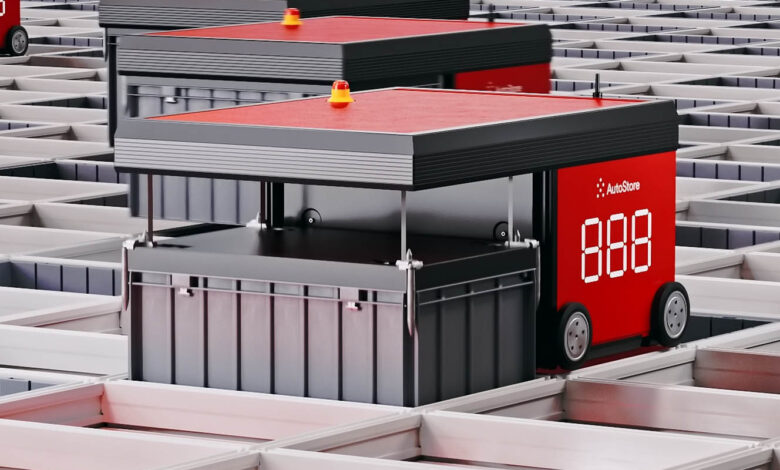
There’s a growing misconception that automation is replacing warehouse workers when in reality, it’s redefining their roles for the better. Powered by advanced AI-powered robotics and software, today’s automation solutions are streamlining order fulfilment while improving working conditions.
By reducing repetitive strain, enhancing ergonomics, and increasing overall workplace safety, AI and automation are directly addressing rising demands for faster handling and delivery – without compromising worker wellbeing. In fact, in the face of persistent labour shortages, high-throughput automated systems are emerging as a strategic enabler.
By delivering measurable ROI and unlocking greater efficiency, automation is helping businesses build smarter, more future-ready supply chain operations. Here’s how forward-thinking businesses can use automation not just to accelerate speed and efficiency, but to create a more human-centric workplace.
Tackling the labour shortage with human-centric automation
The warehousing industry, especially in the UK, is undergoing rapid transformation driven by the growth of e-commerce and rising customer expectations. But despite the influx of investment and thousands of new job opportunities, the sector faces an ongoing labour shortage.
What’s more, traditional Person-to-Goods models, where workers walk long distances to retrieve items, are no longer sustainable. They’re inefficient, error-prone, and place significant strain on employees. In contrast, modern high-throughput automated systems use robotics to store, retrieve, and deliver items with minimal human input – saving time, space, and labour.
For example, THG reported a 40% reduction in variable labour costs after automating its Manchester distribution centre. That kind of efficiency not only addresses workforce gaps but also enables staff to focus on work that’s more fulfilling, helping reduce employee turnover and training costs while improving throughput. This is particularly relevant in today’s landscape, where volatility in wages and increasing pressure on warehouse operations are placing significant strain on the bottom line. In the last two years alone, THG has seen its staff costs rise by over 35%, driven by increasing salaries, government taxation and employee benefits.
Ergonomics and efficiency
Ergonomics is another critical pillar of modern warehouse transformation. Poor ergonomic design leads to fatigue, injury, and inefficiency – all of which impact efficiency and overall ROI.
Automation, especially in cube-based systems, directly addresses these challenges. By delivering goods to workers, automation reduces unnecessary walking, lifting, or bending. Robotic piece-picking systems and intuitive interfaces further support faster, more accurate work with less physical strain. By taking over the most repetitive and physically demanding tasks, these systems free up workers to focus on higher-value, specialist roles, enhancing job satisfaction while increasing overall efficiency and throughput.
The impact goes beyond comfort. When tools, equipment, and workflows are optimised and within easy reach, workers can pick, pack and fully prepare parcels for shipment, streamlining operations and reducing downstream processing and cost. The cumulative effect? Faster order processing, fewer injuries, and faster delivery times.
Cognitive ergonomics matters too. Well-lit, organised, and quiet workspaces support concentration, reduce mental fatigue and enable better decision-making. When paired with automation, ergonomic design pushes performance to even further heights and reach higher levels of customer service.
Investing in people while driving efficiency
Payroll is typically the largest expense for any business, which makes it essential to invest in talent that drives real value. That means understanding each employee’s contribution to the bottom line and identifying opportunities to eliminate non-value-adding work.
High-throughput automation systems can help reduce manual administrative tasks and free up employees to focus on higher-impact activities. Whether that’s improving customer service, overseeing quality control or developing new skills. This shift boosts efficiency, improves job satisfaction, and supports better recruitment and retention in a highly competitive labour market.
But efficiency isn’t just about labour. It’s about making the most of what you already have. According to Savills, global warehousing costs (including rent, service charges, and taxes) rose by 3.6% in the 12 months to March 2025. Europe saw a sharper increase of 5.3% while London’s total occupier costs reached around $49 per sq ft.
In this environment, space is a strategic asset. Businesses that can maximise their current footprint or open smaller, better-located facilities stand to gain a meaningful competitive edge.
Building the workforce of tomorrow
Technology alone won’t transform warehousing – success depends just as much on people. According to PwC’s latest Digital Trends in Supply Chain Survey, only 8% of tech executives said their investments had fully met expectations. Poor implementation was a key barrier, highlighting the need to prioritise adoption alongside innovation.
Bridging this gap demands systems that are intuitive to use, supported by hands-on training and continuous learning. Technology providers can play a valuable role here by helping organisations shorten time to value while boosting user confidence and satisfaction. For example, some organisations report that new workers become proficient with robotic systems within an hour.
When thoughtfully introduced, automation doesn’t need to be disruptive. Scalable solutions with quick installation and seamless integration can enhance throughput without overhauling existing infrastructure.
To fully unlock automation’s value, businesses must invest in people. That means identifying current training needs, evolving job roles, and hiring for new capabilities. Empowering frontline teams to help shape smarter processes fosters a culture where people and technology improve together.
The warehouses of the future won’t be run entirely by robots. Instead, they’ll be shaped by empowered, tech-enabled teams working alongside advanced automation solutions. Forward-thinking companies are building that future today – creating environments where every square foot and every worker delivers more value.





